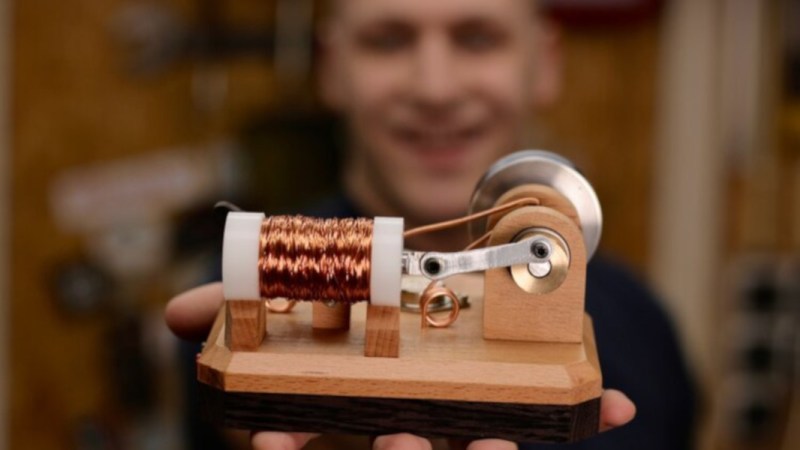A solenoid engine is a curiosity of the electrical world. By all measures, using electricity to rotate something can be done almost any other way with greater efficiency and less hassle. But there’s just something riveting about watching a solenoid engine work. If you want to build one of your own and see for yourself, [Emiel] aka [The Practical Engineer] has a great how-to.
For this build though he used a few tools that some of us may not have on hand, such as a lathe and a drill press. The lathe was used to make the plastic spool to hold the wire, and also to help wind the wire onto the spool itself rather than doing it by hand. He also milled the wood mounts and metal bearings as well, and the quality of the work really shows through in the final product. The final touch is the transistor which controls power flow to the engine.
If you don’t have all of the machine tools [Emiel] used it’s not impossible to find substitute parts if you want to build your own. It’s an impressive display piece, or possibly even functional if you want your build to have a certain steampunk aesthetic (without the steam). You can even add more pistons to your build if you need extra power.















Would the flyback voltage eventually hurt the transistor?
How about using a hall-effect sensor and some adaptive logic (mcu) to adjust the timing to maximize the speed?
I haven’t found the circuit diagram from the link, but you can easily include a free wheeeling / flyback diode across the coil.
I had indeed added a flyback diode to prevent any damage. However at first I didnt have it and the transistor still works.
better yet if you use a copper pipe and wrap it in masking tape you can cut out a triangle from the tape and rotate the pipe from the output with a drive belt. the taper of the triangle from one side to the opposite vertex makes for a really simple PWM circuit to do speed control with, having a sliding contact running along the outside of the pipe works to act as a throttle pretty effectively.
Solenoid powered engines seem to be the new shit.
Did I miss something?
THey’re easy, fun, and have the feel of, say, a Mamod steam engine, without the mess. THey are not new (designs in 1930’s projects-for-boys type books, even), but, ya, they seem to be having a little resurgence.
Coolest I have seen in the last few years is a three cylinder (? maybe a two…) Shay locomotive model powered by one. properly modeled valve gear did the switching. I don’t recall the magazine (For the younger readers, we used to distribute information using dead trees processed into thin, smooth skins, with words and pictures printed on them)
Younger reader: what’s a tree?
fun little project with a very visible result
Same motor that is used in A lot of new refrigerator compressors now. LG Inverter compressors are basically solenoid motors with a piston.
where’s the STL files??
It might be worth noting that in yesterday’s 100-year-old-clock article that clock used a solenoid+lever+rachet mechanism for its self-winding mechanism (likely for lower wear and longer life than a brushed motor) and this may be a niche application for solenoid motors.
I started making these in the early 70s. One of my favorite past times still. The challenge for new builders is to make it do something. I made some RC vehicles and other whacky machines using mine.
Flywheel from left to right and the connector from solenoid on flywheel with different thickness disk on other end it would be neat